Tennessee is a southeastern state with various terrains and landforms, including mountains, valleys, hills, and plains. Moreover, the country’s most visited national park, the Great Smoky Mountains National Park, is located in eastern Tennessee!
The state is part of the temperate deciduous forest biome. It is considered the inland state with the largest biological diversity, primarily thanks to the aforementioned national park. More than half of the state’s territory is covered by forests, indicating that Tennessee is abundant in trees, shrubs, and vines!
If you’ve ever wondered what precisely you can find in Tennessee’s natural gems or whether the state is a must-see destination for plant enthusiasts, we’re here to help! Keep reading to learn about some astounding native plants in Tennessee!
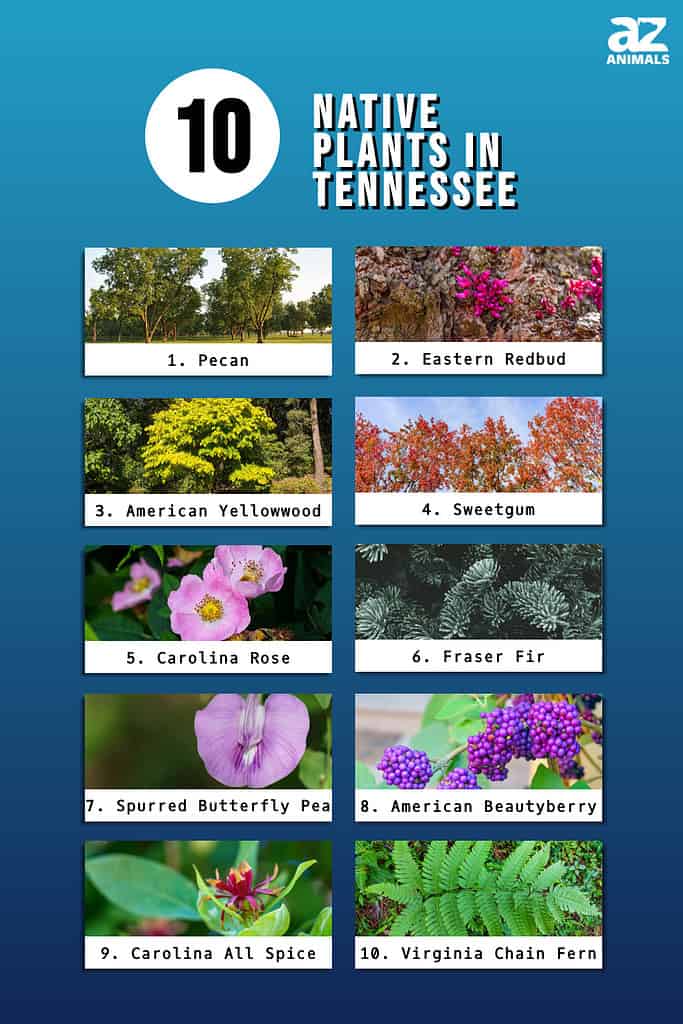
1. Pecan
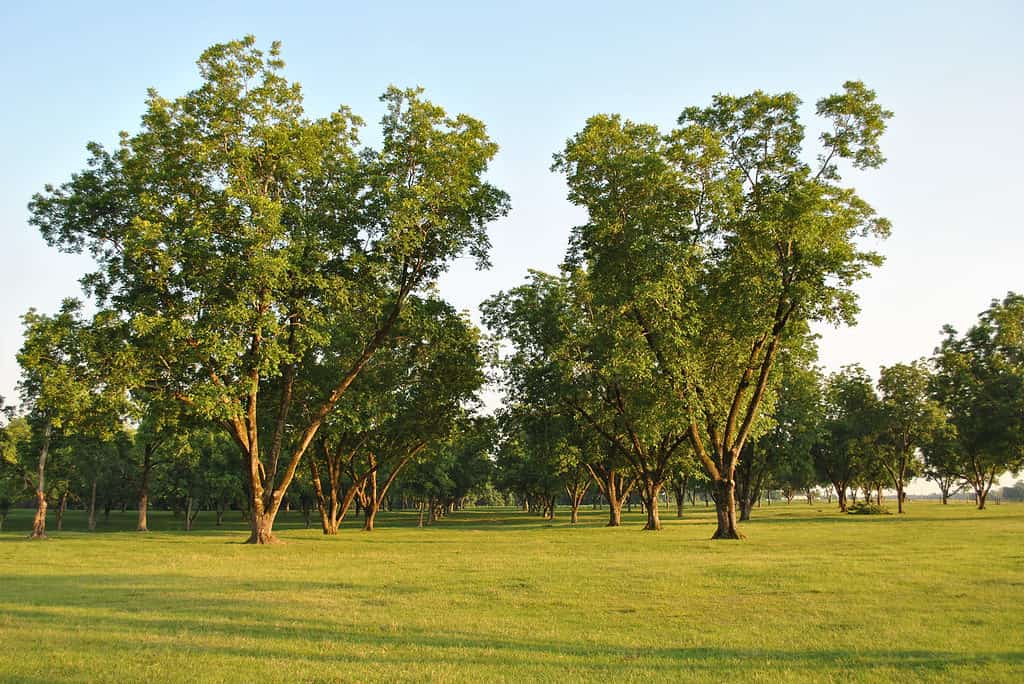
The pecan tree is a deciduous hickory plant that grows up to 131 feet.
©Tayloradempsey/Shutterstock.com
| Pecan | |
|---|---|
| Scientific name | Carya illinoinensis |
| Type of plant | Deciduous tree |
| Distribution | Southern United States, northern Mexico |
The pecan tree is a deciduous hickory plant that grows up to 131 feet. However, some specimens have reached an extraordinary height of 144 feet! Its trunk is around 6 feet in diameter, and the tree spreads about 39-75 feet wide.
It has alternate leaves equipped with 9-17 leaflets. The pecan fruit is a drupe, and the tree seeds are edible nuts that can be eaten raw or cooked. They’re often added to desserts like cookies, pecan pies, or ice creams.
In the United States, pecan trees are widely distributed in Texas, Louisiana, Mississippi, and Arkansas. In Tennessee, they’re primarily found in the state’s western part.
2. Eastern Redbud
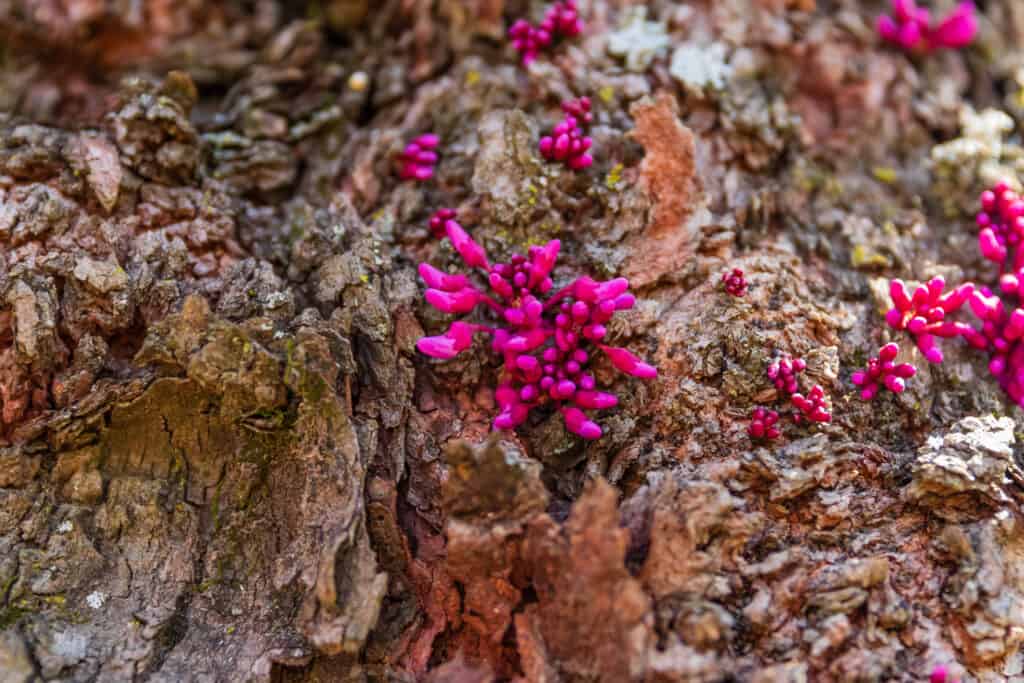
The eastern redbud deciduous plant can develop as a shrub or a small tree, depending on its habitat.
©iStock.com/Marine2844
| Eastern Redbud | |
|---|---|
| Scientific name | Cercis canadensis |
| Type of plant | Deciduous shrub or small tree |
| Distribution | Throughout the central and southeastern United States, Mexico |
The eastern redbud deciduous plant can develop as a shrub or a small tree, depending on its habitat. However, it generally grows 20-30 feet tall and spreads around 26-33 feet wide. Its trunk is short, twisted, and equipped with spreading branches.
The bark is dark and smooth when young, becoming scaly with ridges when it matures. The plant produces pink flowers measuring 0.5 inches long. They usually bloom from spring to early summer and appear on bare stems or on the trunk. These stunning flowers attract pollinators like carpenter bees and blueberry bees.
Eastern redbud fruits are unequally oblong and acute at each end. They fully ripen by midsummer and fall in early winter. The fruit contains 10-12 chestnut brown seeds.
Eastern redbud shrubs or trees can be found throughout Tennessee.
3. American Yellowwood

American yellowwood usually grows up to 49 feet tall, being a small to medium-sized tree.
©Peter Turner Photography/Shutterstock.com
| American Yellowwood | |
|---|---|
| Scientific name | Cladrastis kentukea |
| Other common names | Kentucky yellowwood, Virgilia |
| Type of plant | Deciduous tree |
| Distribution | Southeastern United States |
American yellowwood usually grows up to 49 feet tall, being a small to medium-sized tree. Its broad, rounded crown makes it easy to distinguish from other deciduous trees. Moreover, it has smooth gray bark and compound pinnate leaves with alternate leaflets.
American yellowwood blooms in early summer and exhibits its beautiful white flowers that grow on panicles measuring 12-14 inches long and 5-6 inches wide. American yellowwood fruits are smooth and contain dark brown 4-6 seeds.
These trees are limited only to a small portion in the southern United States, growing primarily in eastern Tennessee, south-central Kentucky, and parts of Arkansas and Alabama.
4. Sweetgum

Sweetgum bark is light brown and deeply fissured, while the branches are covered in cork.
©iStock.com/sundry photography
| Sweetgum | |
|---|---|
| Scientific name | Liquidambar styraciflua |
| Other common names | Hazel pine, alligatorwood, bilsted, American storax, satin-walnut, American sweetgum |
| Type of plant | Deciduous tree |
| Distribution | Eastern North America, Central America, and Mexico |
American sweetgum is typically a medium-sized tree. However, sometimes it can reach 150 feet in the wild. On average, its trunk measures around 2-3 feet in diameter. Its most distinctive feature is its bark, alongside its branches and twigs. They grow in a way that, if looked at from far, the tree branches resemble a reptile, hence its common name “alligatorwood.”
Sweetgum bark is light brown and deeply fissured, while the branches are covered in cork. The dark green leaves are long, broad, smooth, and shiny. During autumn, the tree becomes a brilliant combination of colors as the leaves turn red, orange, yellow, or purple. As for the flowers, they bloom in spring, have a green color, and feature rusty hairs.
A study shows that sweetgum trees have numerous medicinal properties. For example, the sap was once used to treat skin problems, ulcers, and coughs. At the same time, the oil from the leaves is a major antimicrobial agent. Other sweetgum tree extracts have antioxidant, chemopreventive, and anti-inflammatory properties.
5. Carolina Rose
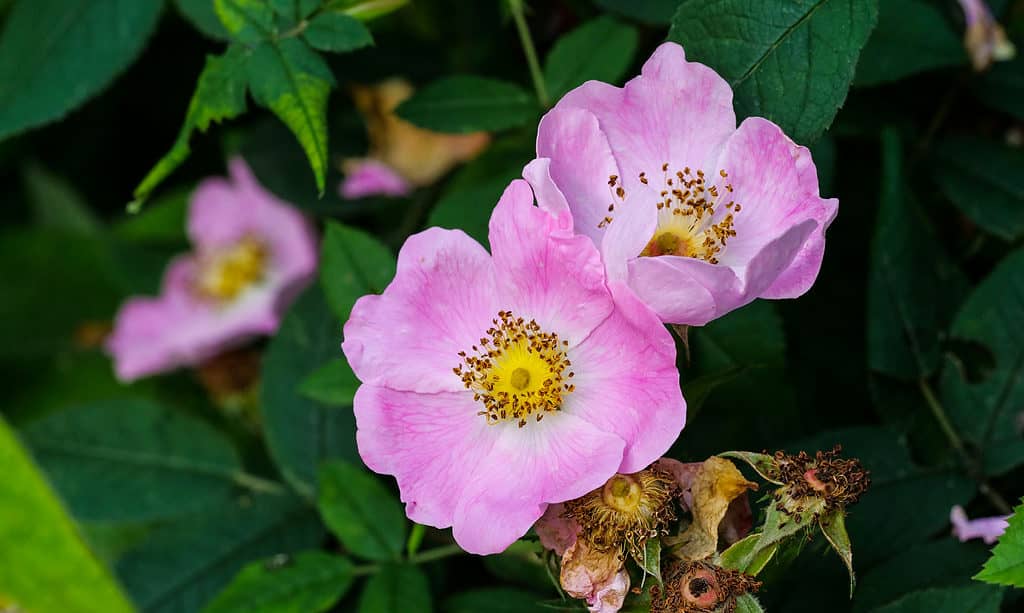
The Carolina rose shrub has erect grayish-brownish stems, needle-like thorns, and fragrant flowers.
©Brookgardener/Shutterstock.com
| Carolina Rose | |
|---|---|
| Scientific name | Rosa carolina |
| Other common names | Prairie rose, pasture rose |
| Type of plant | Perennial shrub |
| Distribution | Eastern North America |
The Carolina rose shrub has erect grayish-brownish stems, needle-like thorns, and fragrant flowers. The light pink flowers bloom in early summer, have five petals, and are yellow at the center. The leaves are dark green and smooth to the touch.
In the wild, the Carolina rose is common in woodlands, prairies, savannas, and upland forested areas and is found in most eastern parts of the North American continent. This plant is a very popular garden plant, providing a unique color and scent to people’s yards. It grows in well-drained soils and requires regular watering and full sun to partial shade.
6. Fraser Fir

The Fraser fir tree is an evergreen coniferous plant growing around 30-50 feet tall.
©Iris_Images/Shutterstock.com
| Fraser Fir | |
|---|---|
| Scientific name | Abies fraseri |
| Type of plant | Evergreen coniferous tree |
| Distribution | Southeastern Appalachian Mountains |
The Fraser fir tree is an evergreen coniferous plant growing around 30-50 feet tall and having a trunk diameter of roughly 16-20 inches. It has a conical crown, thin, smooth bark, and straight branches that can grow horizontally or slightly upwards from the trunk. Young trees have resinous blisters on the trunk, while mature Fraser fir bark is fissured and scaly.
This coniferous tree has needle-like, spirally arranged leaves. It produces erect, cylindrical cones that are dark purple when young and pale brown when they reach maturity.
Fraser firs are found in a very small portion of the United States: in the southeastern Appalachian Mountains. They grow in eastern Tennessee, western North Carolina, and southwestern Virginia.
7. Spurred Butterfly Pea
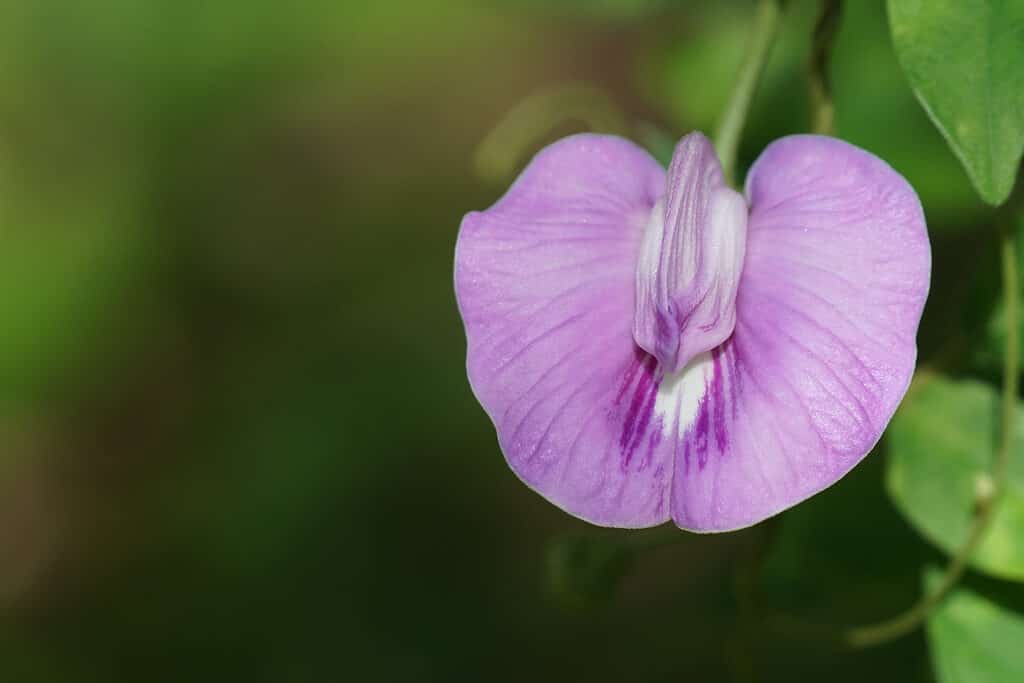
The spurred
butterfly
pea is a herbaceous vine that reaches around 6.5 feet tall.
©Doikanoy/Shutterstock.com
| Spurred Butterfly Pea | |
|---|---|
| Scientific name | Centrosema virginianum |
| Other common names | Wild blue vine, wild pea, blue bell |
| Type of plant | Perennial herbaceous vine |
| Distribution | From Uruguay and Argentina to the eastern United States and Bermuda |
The spurred butterfly pea is a herbaceous vine that reaches around 6.5 feet tall. Its alternate leaves are pinnately divided, while the leaflets can be lanceolate-oblong or linear to ovate to oblong.
The vine produces purplish, bluish, or nearly white flowers with a unique appearance, primarily thanks to their inverted banner specialized for “accommodating” pollinators.
This vine is common in coastal uplands and pine lands and thrives in sunny areas.
8. American Beautyberry
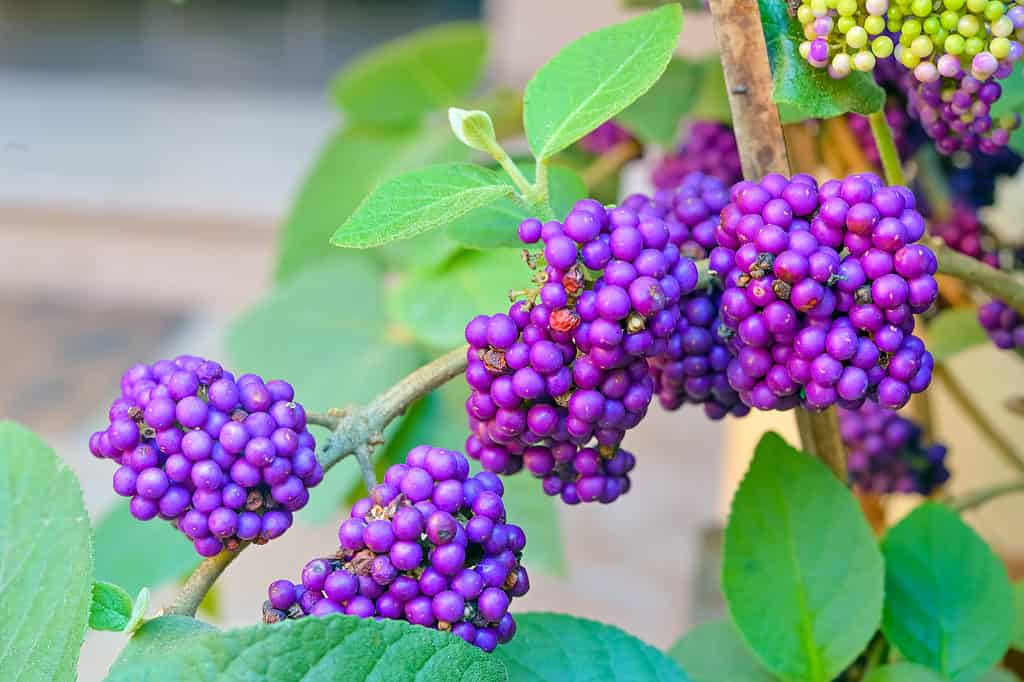
The American beautyberry is very popular in landscaping and gardening thanks to its distinctive appearance.
©Amvi Jovas/Shutterstock.com
| American Beautyberry | |
|---|---|
| Scientific name | Callicarpa americana |
| Type of plant | Shrub |
| Distribution | Southern United States |
The American beautyberry can be easily distinguished in the wild and in people’s gardens thanks to its deep purple berries that grow in clusters and ripen from September to October. The plant is very popular in landscaping and gardening thanks to its distinctive appearance.
Raw berries are edible, although it’s generally recommended to consume them in small quantities, as they’re astringent and can cause stomach cramps. Besides, this shrub’s berries are often added to jellies and wine, while the roots are used in preparing herbal teas.
9. Carolina All Spice
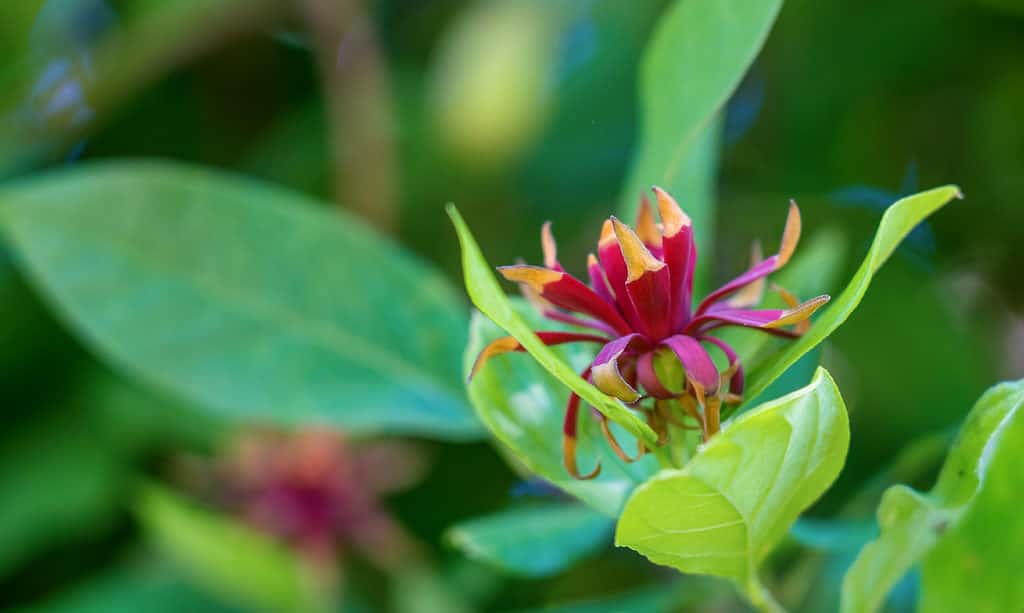
The Carolina all spice is a shrub with dark green leaves that are either ovate or elliptical.
©Martin Hibberd/Shutterstock.com
| Carolina All Spice | |
|---|---|
| Scientific name | Calycanthus floridus |
| Other common names | Spice bush, eastern sweetshrub |
| Type of plant | Shrub |
| Distribution | Southeastern United States |
The Carolina all spice, sometimes called the eastern sweetshrub or the spice bush, is a shrub with dark green leaves that are either ovate or elliptical. They have pale undersides and are oppositely arranged on the shrub’s stem.
The shrub flowers in spring and reveals its reddish-purplish, solitary flowers. These distinctive flowers can have various forms: ellipsoid, globose, cylindrical, and pyriform. The fruits are medium-sized, reaching approximately 3 inches long and 2 inches in diameter.
The spice brush is a popular horticultural plant thanks to its stunning appearance and pleasant fragrance. Moreover, some say that its edible bark can perfectly substitute cinnamon, while the flowers can be added to teas for flavor.
10. Virginia Chain Fern
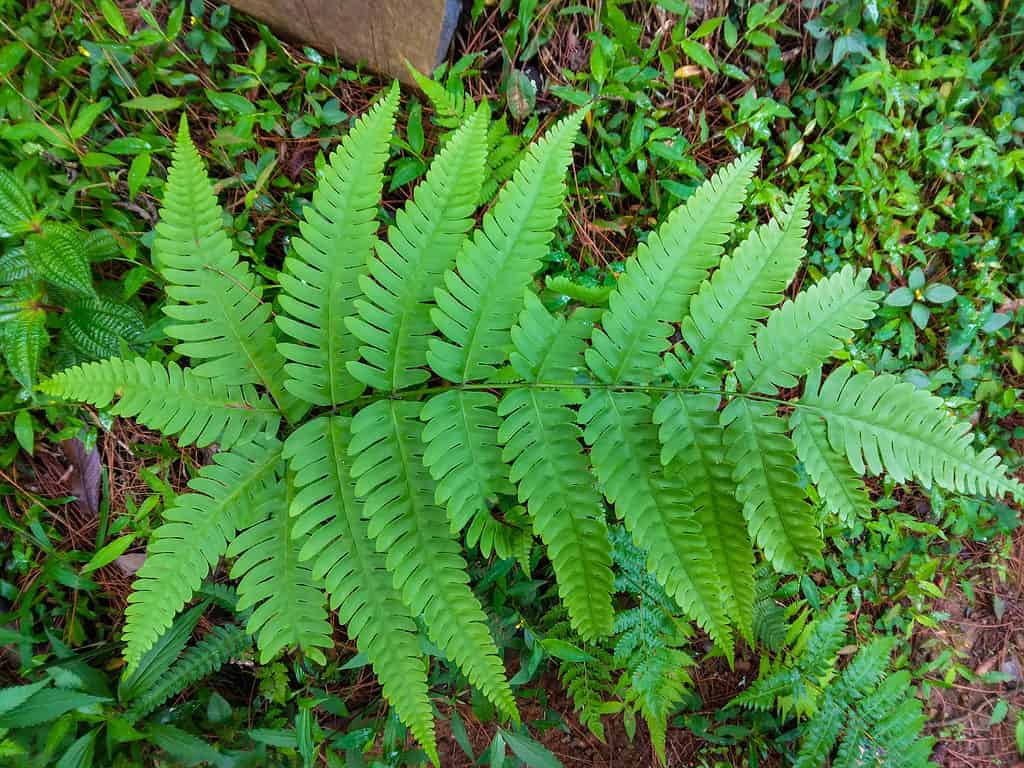
The Virginia chain fern is the only species in the
Anchisteagenus.
©Dry_indri/Shutterstock.com
| Virginia Chain Fern | |
|---|---|
| Scientific name | Woodwardia virginica or Anchistea virginica |
| Type of plant | Deciduous fern |
| Distribution | Eastern North America |
The Virginia chain fern, or Woodwardia virginica, is the only species in the Anchistea genus. The fern has long, creeping underground stems which produce widely separated leaves that grow as tall as 4 feet. The red-brownish sori where the spores are produced give the plant a unique appearance.
This plant grows in wet soils and can be found in acid bogs, streams, or swampy slopes. Sometimes it’s grown as an ornamental garden plant or cultivated as a greenhouse.
Summary of 10 Native Plants in Tennessee
Here’s a recap of the 10 plants we looked at that are native to the state of Tennessee.
| Number | Plant | Scientific Name | Type of Plant |
|---|---|---|---|
| 1 | Pecan | Carya illinoinensis | Deciduous tree |
| 2 | Eastern Redbud | Cercis canadensis | Deciduous shrub or small tree |
| 3 | American Yellowwood | Cladrastis kentukea | Deciduous tree |
| 4 | Sweetgum | Liquidambar styraciflua | Deciduous tree |
| 5 | Carolina Rose | Rosa carolina | Perennial shrub |
| 6 | Fraser Fir | Abies fraseri | Evergreen coniferous tree |
| 7 | Spurred Butterfly Pea | Centrosema virginianum | Perennial herbaceous vine |
| 8 | American Beautyberry | Callicarpa americana | Shrub |
| 9 | Carolina All Spice | Calycanthus floridus | Shrub |
| 10 | Virginia Chain Fern | Woodwardia virginica or Anchistea virginica | Deciduous fern |
The photo featured at the top of this post is © iStock.com/sundry photography
Sources
- Gardenia, Available here: https://www.gardenia.net/native-plants/tennessee
- National Library of Medicine, Available here: https://www.ncbi.nlm.nih.gov/pmc/articles/PMC4441155/
Thank you for reading! Have some feedback for us? Contact the AZ Animals editorial team.







